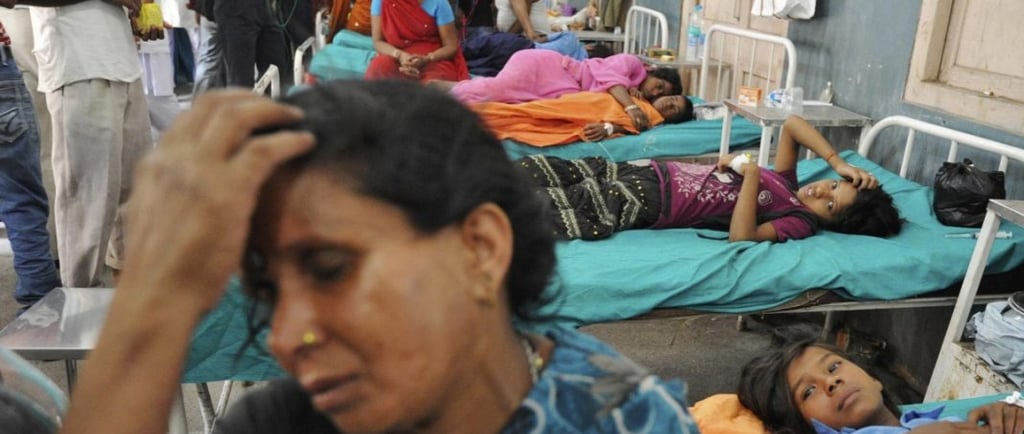Are people really covered under Ayushmaan Bharat? The reality of access to hospitals
HEALTH


The government proudly claims that Ayushman Bharat Pradhan Mantri Jan Arogya Yojana (AB-PMJAY) has successfully covered 12 crore families and 55 crore people, making it one of the largest healthcare schemes in the world. However, beneath this achievement lies a troubling reality—a severe shortage of empaneled hospitals in many states. While millions hold Ayushman Bharat cards, the number of hospitals available to treat them, particularly in states like Bihar and Madhya Pradesh, is alarmingly low. This disparity raises critical questions about healthcare accessibility and the scheme’s ability to deliver on its promise of universal care.
Empanelment Shortfalls in Bihar and Madhya Pradesh
While the scheme’s ambition is laudable, the availability of healthcare infrastructure under Ayushman Bharat remains uneven across various states. Two major states, Bihar and Madhya Pradesh, illustrate this challenge.
Madhya Pradesh has 1,007 hospitals empaneled under the scheme, with each hospital responsible for handling approximately 39,975 Ayushman Bharat cardholders.
Bihar, with 972 hospitals, faces a similar burden, with each hospital serving 30,376 cardholders. This mismatch between the number of hospitals and the population needing care puts immense pressure on the healthcare system, limiting access to timely treatment.
The situation is even more concerning in certain districts of Bihar, where the disparity is stark. Sixteen districts have fewer than 20 empaneled hospitals. For instance, while Patna, the most populous district, has 120 empaneled hospitals, Purbi Champaran, the second most populous district, has only 29 hospitals, highlighting the regional inequity in healthcare access. Despite having issued 2.95 crore Ayushman Bharat cards in Bihar, the inadequate number of empaneled hospitals underscores the strain on the system.
These figures stand in stark contrast to the national average of 11,611 cardholders per hospital. The gaps in hospital infrastructure severely limit the scheme's ability to provide timely and effective healthcare to millions of beneficiaries in these states.
Uttar Pradesh and Maharashtra: A Mixed Picture
Uttar Pradesh, India’s most populous state, provides a more balanced picture. Despite a population exceeding 24 crore, Uttar Pradesh has empaneled 5,582 hospitals, significantly improving healthcare access with a manageable ratio of 6,398 cardholders per hospital. This relatively better performance stands in contrast to the state’s high out-of-pocket healthcare expenditure of ₹60,800 crore in 2020.
However, Maharashtra, with its 2.79 crore Ayushman Bharat cardholders, is also grappling with healthcare challenges. Despite its stronger infrastructure, with one hospital for every 27,878 cardholders, Maharashtra had ₹34,177 crore in out-of-pocket healthcare expenses in 2020. The burden of healthcare costs is still a concern, signaling that hospital empanelment alone does not guarantee reduced personal expenses, especially when the number of empaneled hospitals falls short.
Karnataka and Andhra Pradesh: The Leaders in Accessibility
In contrast, Karnataka and Andhra Pradesh demonstrate better cardholder-to-hospital ratios, improving healthcare access under the scheme. Karnataka has a ratio of 4,854 cardholders per hospital, and Andhra Pradesh follows closely with 6,398 cardholders per hospital. Although these states are performing better than many others, there is still room for improvement, especially in rural areas that remain underserved.
National Overview: Private vs Government Empanelment
As of now, a total of 29,281 hospitals are empaneled under Ayushman Bharat-PMJAY, with 12,625 being private hospitals and the rest being government-run. This division shows that while the private sector plays a significant role in providing healthcare under the scheme, the participation of government hospitals needs to increase.
The current challenge is the unequal distribution of hospitals across both states and districts, exacerbating the urban-rural divide. For Ayushman Bharat to succeed, the government must not only empanel more hospitals, especially in underserved areas, but also ensure that all government hospitals come under the scheme’s umbrella. Increasing private hospital participation is essential to achieving a wider reach and reducing the burden on overworked healthcare facilities in states like Bihar and Madhya Pradesh.
Theoretical Framework: Healthcare Access and Equity
The success of Ayushman Bharat hinges on the "healthcare accessibility" model, which comprises three key factors: physical access, affordability, and quality of care. While the scheme addresses affordability by offering free healthcare services, physical access to hospitals remains a significant barrier, particularly in underserved regions like Bihar and Madhya Pradesh.
Empaneling more hospitals is only part of the solution. The government needs to focus on both interstate and intrastate equity by increasing the number of empaneled facilities in rural and semi-urban areas, ensuring that healthcare is accessible to all, regardless of geographic location.
Conclusion: The Road Ahead for Ayushman Bharat
Ayushman Bharat is undoubtedly a transformative healthcare scheme, but its success is limited by the disparity in hospital empanelment across states. Madhya Pradesh and Bihar serve as key examples of the challenges facing the system, where a lack of empaneled hospitals puts undue strain on healthcare providers and limits access for beneficiaries. In contrast, states like Uttar Pradesh, Karnataka, and Andhra Pradesh show that with better infrastructure planning and hospital coverage, healthcare access can be vastly improved.
However, as the data suggests, the government must focus on equitable distribution of healthcare facilities—both public and private—across all regions. By ensuring that all government hospitals are empaneled and encouraging more private hospitals to join the scheme, Ayushman Bharat can move closer to achieving its goal of accessible, affordable healthcare for all.
The scheme's long-term success will require a concerted effort to address both interstate and intrastate disparities, ensuring that the promise of universal healthcare reaches even the most remote corners of the country.
